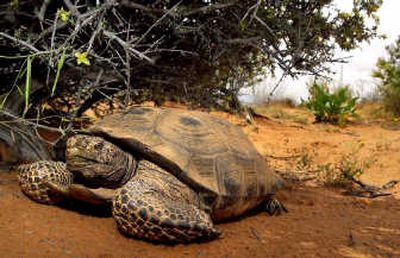Desert tortoise population declining

SALT LAKE CITY – It’s been a tough few years for the shelled sentinels scratching out a living in Utah’s southwestern desert.
The population of desert tortoises in the scrubby 62,000 acres of Red Cliffs Desert Reserve has been declining steadily since 2000. New numbers for 2007 show the lowest count since regional monitoring began in 1998.
Drought, fire, disease and other factors have taken a toll. Eight years ago, the number of adult tortoises there was estimated at more than 3,200. Now it’s about 1,700.
“We definitely have a level of concern,” said Ann McLuckie, a biologist with the Utah Division of Wildlife Resources in St. George.
McLuckie was traveling Friday to Zion National Park to mark World Turtle Day with school kids and others interested in the survival of one of the desert’s most peculiar residents.
Desert tortoises spend up to 95 percent of their time in underground burrows, can have shells 15 inches across, bob their heads oddly during courtship and are capable of noises described as hisses, grunts and whoops.
“They’re fascinating,” McLuckie said. “They’ve maintained basically the same body shape for over 200 million years so they’re kind of vestiges of the past.”
The Red Cliffs reserve was established 12 years ago to protect wildlife from human encroachment in Utah’s rapidly growing Washington County.
The desert tortoise, a federally protected species, has benefited from the designation but that doesn’t mean life is easy.
Although the tortoises are desert dwellers, they can survive only so many dry years. Drought dries up freestanding water sources needed to digest food and expel salt from their bodies. With less water available, tortoises tend to eat less and become weakened.
The proliferation of non-native cheatgrass is also a problem. Instead of fire dying out from a lack of fuel in the desert, cheatgrass allows it to move quickly across the landscape.
Some tortoises either burn up in the flames or see their primary food sources – wildflowers, cacti and grasses – destroyed, McLuckie said.
There’s an indirect threat, too: Predators such as coyotes have shifted their diets toward tortoises as other sources disappear from fire or drought.
A large fire roared through the reserve in 2005, and the tortoises are still feeling the effects, McLuckie said.
“I definitely think there’s long-term impacts,” she said.
There’s also a concern that weakened turtles might be more susceptible to disease, including an upper-respiratory ailment first discovered in Utah’s wild tortoises in the 1970s.
“Whenever there’s stress in a population, like drought, that exacerbates the disease,” McLuckie said.
The Red Cliffs area has long been seen as a stronghold for the Mohave desert tortoise, which lives in parts of Utah, Nevada, California and Arizona. Density there tends to be higher than other populations in the region, according to Roy Averill-Murray, desert tortoise recovery coordinator for the U.S. Fish and Wildlife Service in Reno, Nev.
Although scientists keep a closer eye on the number of tortoises per square mile than the overall population, Averill-Murray said he’s concerned with the mortality rates in the Red Cliffs area.
There’s been some discussion about transplanting tortoises to the area but nothing formal has been proposed.
Keeping track of them can be difficult because they often live in remote places and tend to stay out of sight. Some are affixed with tracking devices.
“We know they can live 60 years in the wild and even longer in captivity,” Averill-Murray said. “They can even live longer than the researchers studying them.”